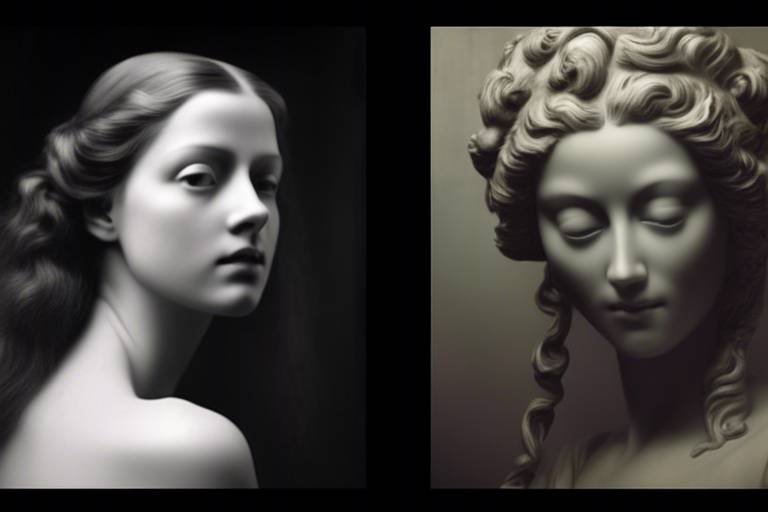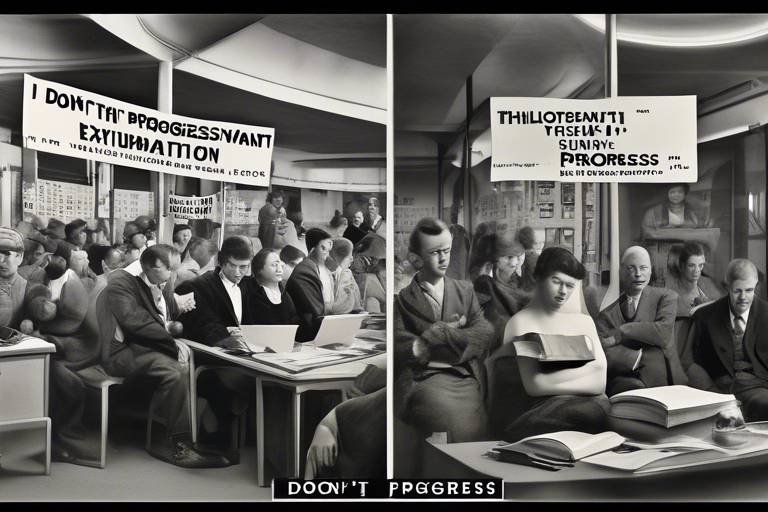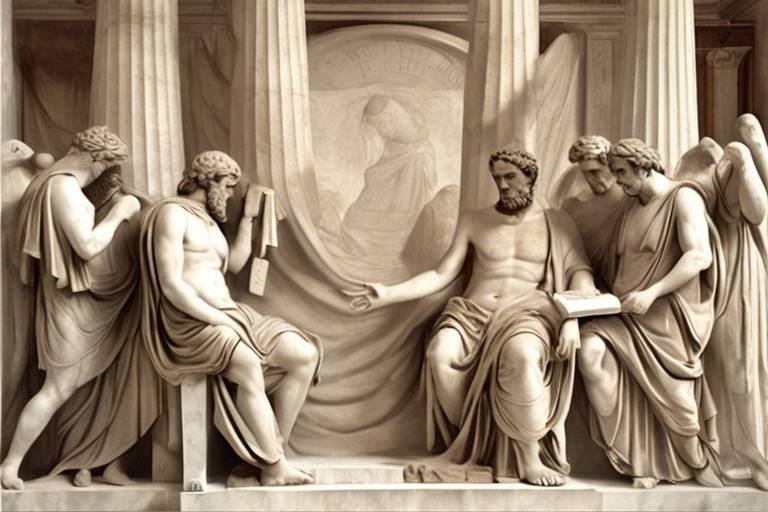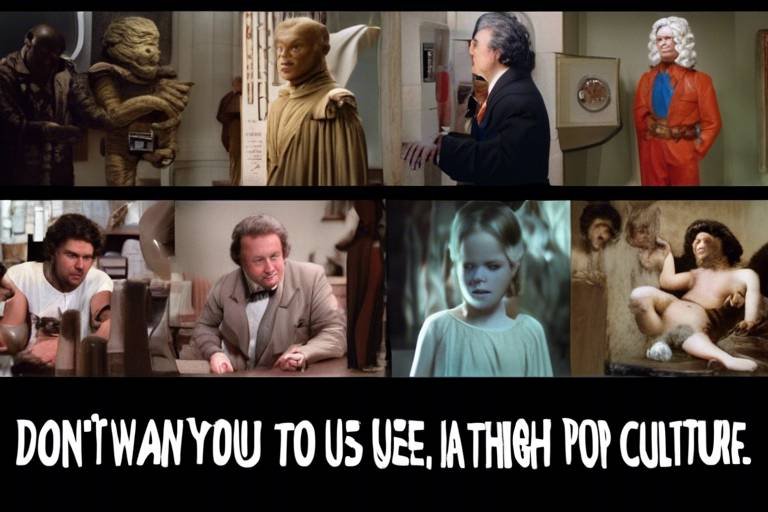Analyzing the Concepts of Beauty in Philosophy
Beauty has been a captivating topic in philosophy for centuries, weaving its way through the thoughts of great thinkers and influencing countless aspects of human experience. From ancient times to the modern era, the exploration of beauty has sparked debates, inspired art, and shaped ethical considerations. But what exactly is beauty? Is it merely a visual delight, or does it encompass deeper meanings that resonate with our very existence? In this article, we will embark on a journey to unravel the multifaceted nature of beauty in philosophical discourse, examining historical perspectives, contemporary theories, and the implications of beauty in art, ethics, and existence.
To truly understand beauty, we must first dive into its historical context. The evolution of beauty as a concept has been profoundly influenced by various philosophers, each contributing their unique insights. For instance, the ancient Greeks laid the groundwork for discussions about beauty, with figures like Plato and Aristotle offering contrasting yet complementary views. Plato introduced the idea of beauty as an ideal form, while Aristotle grounded beauty in the tangible world, emphasizing its connection to functionality. As we traverse through history, we will uncover how these foundational ideas have shaped modern interpretations of beauty and continue to resonate in contemporary thought.
In addition to historical perspectives, we must also consider the role of beauty in art and ethics. Beauty is not just an aesthetic experience; it has the power to evoke emotions, provoke thoughts, and influence moral judgments. The interplay between beauty and ethics raises intriguing questions: Can something be beautiful yet morally questionable? How does the perception of beauty affect our understanding of virtue? These inquiries lead us to examine the significance of beauty in our lives, encouraging us to reflect on our own values and beliefs.
As we delve deeper into the subject, we will explore modern theories of beauty that challenge traditional notions. The contemporary discourse has shifted towards recognizing beauty as a subjective experience, shaped by cultural and individual factors. This perspective invites us to reconsider what beauty means in today's diverse society, where artistic expressions often defy conventional standards. By analyzing these modern theories, we can appreciate the dynamic nature of beauty and its evolving significance in our lives.
Ultimately, the exploration of beauty in philosophy is not just an academic exercise; it is a deeply personal journey that invites us to reflect on our own experiences and perceptions. As we navigate through the complexities of beauty, we will uncover insights that resonate with our shared humanity, reminding us that beauty is not just found in art or nature, but in the very essence of existence itself.
- What is the philosophical definition of beauty?
Beauty in philosophy often refers to an ideal quality that evokes pleasure or admiration, which can be subjective or objective depending on the philosophical perspective. - How did Plato view beauty?
Plato considered beauty as an ideal form that transcends the physical, linking it to the concept of the Good and existing in a higher realm of reality. - What was Aristotle's perspective on beauty?
Aristotle grounded beauty in the physical world, emphasizing its relationship with functionality and how it can influence ethical considerations. - How do modern theories of beauty differ from traditional views?
Modern theories often view beauty as subjective, shaped by cultural and individual experiences, challenging the idea of universal beauty standards. - What role does art play in our understanding of beauty?
Art plays a crucial role in shaping our perceptions of beauty, often redefining it and challenging conventional norms through creative expressions.

The Historical Context of Beauty
Understanding beauty requires a look into its historical evolution, from ancient Greek ideals to modern interpretations. Throughout history, beauty has been a subject of fascination, debate, and deep philosophical inquiry. The concept of beauty is not static; it has transformed over centuries, influenced by cultural shifts, artistic movements, and philosophical advancements. To grasp the full scope of beauty, we must delve into the thoughts of key philosophers who have shaped our understanding of this elusive concept.
In ancient Greece, beauty was often associated with harmony and proportion. Philosophers like Plato and Aristotle laid the groundwork for discussing beauty in both metaphysical and practical terms. Plato viewed beauty as an ideal form, a perfect representation that transcends the physical world. In contrast, Aristotle grounded beauty in the tangible, emphasizing the importance of observing beauty in nature and human creations. This divergence in thought set the stage for centuries of philosophical exploration.
As we journey through time, the Renaissance brought a revival of classical ideals, where beauty was celebrated through art and architecture. Artists like Leonardo da Vinci and Michelangelo embodied the principles of beauty through their works, inspiring a cultural movement that valued aesthetics as integral to human experience. The Enlightenment period further expanded the discourse, introducing notions of beauty intertwined with reason and emotion.
In the 19th century, the Romantic movement shifted the focus of beauty towards individual experience and emotion. Thinkers like Immanuel Kant argued that beauty is not merely a property of objects but a subjective experience shaped by personal feelings and cultural context. This perspective paved the way for modern theories that challenge traditional notions of universal beauty, emphasizing the role of the observer in defining what is beautiful.
Today, the conversation around beauty continues to evolve. Contemporary philosophers and artists explore beauty through various lenses, including cultural relativism, subjectivity, and diversity. The historical context of beauty reveals a rich tapestry of ideas, each contributing to our understanding of this complex and multifaceted concept. As we navigate through these philosophical waters, we begin to appreciate that beauty is not just a visual experience but a profound reflection of our values, beliefs, and cultural narratives.
- What is the philosophical definition of beauty? Beauty in philosophy often refers to a quality or combination of qualities that pleases the senses or brings about a sense of aesthetic pleasure.
- How have historical perspectives on beauty influenced modern views? Historical perspectives, such as those from Plato and Aristotle, laid the groundwork for understanding beauty, influencing contemporary thought that emphasizes subjectivity and cultural context.
- Why is beauty important in philosophy? Beauty is important in philosophy as it intersects with ethics, art, and human experience, prompting discussions about what constitutes a good life and how we perceive the world around us.

Platonic Ideals of Beauty
When we dive into the world of philosophy, one name that often shines brightly is Plato. His exploration of beauty transcends mere aesthetics; it reaches into the very fabric of existence. For Plato, beauty is not just what meets the eye; it is a reflection of a higher reality, the ideal forms that govern our understanding of the world. Imagine a world where beauty is more than skin deep—a world where it embodies truth, goodness, and the essence of existence itself. This notion can be quite mind-bending!
Plato's concept of beauty is intricately linked to his Theory of Forms. He posited that everything we see in the physical world is merely a shadow of its true form. In this context, beauty exists in a realm of perfection, untouched by the imperfections of the material world. To illustrate this, consider the difference between a beautiful painting and the ideal of beauty that the artist aims to capture. The painting may be stunning, but it is still just a representation of the true essence of beauty that exists in the realm of forms.
In Plato's dialogue, beauty is often associated with the Good. He believed that the appreciation of beauty leads one closer to understanding the Good, which is the ultimate goal of life. This connection raises an intriguing question: Can we truly appreciate beauty without recognizing its moral implications? Plato seemed to think that beauty and goodness are intertwined, suggesting that the experience of beauty can elevate our souls and guide us toward virtuous living.
Plato's linkage of beauty and the Good is not just a philosophical curiosity; it has profound implications for how we live our lives. When we encounter beauty—be it in nature, art, or human relationships—it stirs something deep within us. It compels us to seek out the good, to aspire to higher ideals. This is where beauty becomes a transformative experience. It encourages us to rise above our mundane existence and strive for something greater.
To grasp this relationship, consider the following points:
- Beauty inspires virtue: Engaging with beauty can lead to a greater appreciation for moral values.
- Beauty as a guiding principle: The pursuit of beauty can guide our actions and decisions toward the good.
- Interconnectedness of ideals: In Plato's view, beauty, goodness, and truth are inseparable threads in the tapestry of existence.
Delving deeper into Plato's Theory of Forms, we find that beauty is not just a fleeting experience; it is a constant in the higher realm. According to Plato, the physical manifestations of beauty—like a stunning sunset or a captivating sculpture—are only reflections of the true form of beauty that exists beyond our perception. This idea can be likened to looking at a photograph of a breathtaking landscape; while the image is beautiful, it can never fully encapsulate the experience of being there in person. The true essence of beauty is elusive, yet it beckons us to search for it.
In this realm of forms, beauty is unchanging and eternal. It serves as a foundation for understanding other concepts, such as justice and love. Plato argues that by contemplating beauty, we elevate our understanding and can access deeper truths about existence. This philosophical journey invites us to ponder: What does it mean to appreciate beauty in its purest form? How does this understanding shape our interactions with the world around us?
Ultimately, Plato's ideals of beauty challenge us to look beyond the surface and seek the profound connections that bind us to the universe. They remind us that beauty is not just an aesthetic experience; it is a pathway to understanding the very nature of reality itself.
- What is Plato's Theory of Forms? Plato's Theory of Forms posits that non-material abstract forms, and not the material world, possess the highest and most fundamental kind of reality.
- How does Plato define beauty? For Plato, beauty is an ideal form that exists beyond the physical world, representing a perfect and unchanging essence.
- What is the relationship between beauty and goodness in Plato's philosophy? Plato believed that beauty and goodness are interconnected, suggesting that the appreciation of beauty can lead to a greater understanding of moral values.

Beauty and the Good
In the realm of philosophy, the connection between beauty and the Good is both profound and intricate. Plato, the great ancient philosopher, often intertwined these two concepts, suggesting that beauty is not merely an aesthetic experience but a pathway to understanding the ultimate Good. But what does this really mean? Imagine beauty as a bridge that leads us to moral enlightenment; it is through appreciating beauty that we can begin to grasp deeper truths about existence and morality.
According to Plato, when we encounter something beautiful, whether it be a work of art, a natural landscape, or even a virtuous person, we are not just experiencing a fleeting emotion. Instead, we are engaging with a reflection of the eternal Forms—those perfect and unchanging ideals that exist beyond our tangible world. In this sense, beauty serves as a reminder of the Good, urging us to aspire towards higher moral standards and ethical living.
To delve deeper into this relationship, consider the following points:
- Beauty as a Reflection of the Good: Plato posited that beautiful things are beautiful because they participate in the Form of Beauty, which is inherently linked to the Good. This suggests that our appreciation of beauty can elevate our understanding of virtue.
- The Ethical Implications of Beauty: If beauty is a reflection of the Good, then engaging with beauty can lead to ethical behavior. For instance, a beautiful piece of art may inspire feelings of compassion or empathy, prompting us to act kindly towards others.
- Beauty and Moral Development: Plato believed that exposure to beauty could cultivate virtues within individuals. Just as a beautiful melody can uplift the spirit, so too can the experience of beauty refine our moral character.
However, the relationship between beauty and the Good is not without its complexities. Critics of Plato's view argue that beauty can exist independently of moral goodness. For example, a stunning painting may evoke admiration yet convey a message that is ethically questionable. This raises the question: can something be beautiful yet morally ambiguous? The answer lies in our subjective interpretations of beauty and goodness, which can vary widely across cultures and individuals.
In contemporary discourse, the link between beauty and the Good continues to evolve. Many philosophers now emphasize the subjective nature of beauty, suggesting that what one person finds beautiful, another may not. This shift invites us to consider how personal experiences, cultural backgrounds, and societal norms influence our perceptions of beauty and its ethical implications. Ultimately, while the connection between beauty and the Good remains a significant theme in philosophy, it is essential to acknowledge the diverse perspectives that shape our understanding of these concepts.
- What is the relationship between beauty and morality? Beauty can inspire moral behavior and ethical considerations, as it often reflects deeper truths about the Good.
- Can something be beautiful but morally wrong? Yes, beauty is subjective, and something can be aesthetically pleasing while conveying morally questionable messages.
- How do cultural differences affect perceptions of beauty? Cultural backgrounds significantly influence what individuals consider beautiful, shaping their ethical judgments and values.

Beauty in the Realm of Forms
When we dive into the depths of Plato's Theory of Forms, we encounter a fascinating perspective on beauty that transcends the mere physicality of objects. According to Plato, beauty is not just what meets the eye; it exists in a higher realm, a world of perfect forms that our physical world merely imitates. Imagine a world where every beautiful thing you see—like a stunning sunset or a captivating piece of art—is merely a shadow of the true essence of beauty that resides in this ethereal realm. This idea invites us to ponder: if beauty exists in a perfect form, what does that mean for our everyday experiences of beauty?
Plato proposed that the physical manifestations of beauty are fleeting and imperfect, while the true beauty in the Realm of Forms is eternal and unchanging. This concept can be likened to the difference between a photograph and the actual scene it captures. The photograph may evoke emotions and admiration, but it can never fully encapsulate the richness of the original experience. In this way, Plato encourages us to look beyond the surface and seek the deeper truths that inform our understanding of beauty.
In this higher realm, beauty is closely intertwined with other ideals, such as truth and goodness. Plato believed that to truly appreciate beauty, one must also understand its relationship with these other forms. For instance, a beautiful piece of art is not merely about its visual appeal; it also embodies truth and goodness in its creation and meaning. This interconnectedness prompts us to ask ourselves: how do we define beauty in our lives, and what values do we associate with it?
Furthermore, Plato's exploration of beauty in the Realm of Forms raises intriguing questions about the nature of our perceptions. If beauty is an ideal that exists beyond our physical reality, then how do we recognize and experience it? This leads to the notion that our appreciation of beauty is a journey of the soul, a quest to connect with the higher forms that inspire us. As we navigate through life, we may find ourselves drawn to certain experiences, artworks, or even people that resonate with this ideal beauty, igniting a spark within us that feels both familiar and profound.
In summary, Plato's concept of beauty in the Realm of Forms invites us to reflect on the deeper significance of beauty beyond its surface-level appeal. By recognizing that beauty is not just a physical attribute but a higher ideal, we can enrich our understanding of art, nature, and even our ethical values. This philosophical lens challenges us to seek beauty not only in what we see but in the essence that lies beneath—an essence that connects us all to something greater than ourselves.
- What is Plato's Theory of Forms?
Plato's Theory of Forms posits that non-physical (but substantial) forms represent the most accurate reality. In this view, the physical world is just a shadow of the true essence of things. - How does beauty relate to truth and goodness in Plato's philosophy?
In Plato's framework, beauty, truth, and goodness are interconnected ideals that inform one another. True beauty embodies truth and goodness, enriching our understanding of each concept. - Can beauty exist independently of our perceptions?
According to Plato, true beauty exists in the Realm of Forms, independent of human perception. Our experiences of beauty are merely reflections of this higher ideal.

Aristotle's Perspective on Beauty
When we dive into , we find ourselves stepping into a world where beauty is not just an abstract ideal but something that can be observed and measured in the physical realm. Unlike his mentor Plato, who believed that beauty existed in a higher, non-physical realm of forms, Aristotle grounded his understanding of beauty in the tangible world around us. For Aristotle, beauty is all about symmetry, proportion, and harmony. Imagine walking through a garden; the balance of colors, the arrangement of flowers, and the overall design create a visual delight that is both pleasing and meaningful. This is the essence of Aristotle's view on beauty—it's rooted in the observable qualities of the world.
One of the most fascinating aspects of Aristotle's theory is how he links beauty to functionality. He believed that an object's purpose plays a crucial role in its beauty. For instance, consider a well-crafted chair. Its beauty isn't merely in its design but also in its ability to serve its function effectively. If a chair is comfortable and supportive, it enhances its aesthetic appeal. In this way, Aristotle’s perspective can be summarized as:
| Aspect | Description |
|---|---|
| Symmetry | Beauty arises from balanced proportions. |
| Functionality | Beauty is enhanced when an object serves its purpose well. |
| Harmony | Elements that work together create a unified aesthetic. |
Aristotle also believed that beauty is not just a matter of personal taste; it has an objective quality that can be appreciated universally. He argued that while individual preferences may vary, there are certain principles of beauty that resonate across cultures and time periods. This idea challenges the notion that beauty is entirely subjective, suggesting instead that there are underlying truths that can be recognized by anyone who takes the time to observe and reflect.
Furthermore, Aristotle integrated beauty into his ethical framework. He posited that beauty and goodness are interconnected. Just as a beautiful object can elevate our spirits, a virtuous action can be seen as beautiful in its own right. This intertwining of aesthetics and ethics leads us to consider how our perceptions of beauty can influence our moral judgments. For Aristotle, the appreciation of beauty in art, nature, and human behavior is not merely a superficial experience; it holds deeper implications for our understanding of virtue and ethics.
To sum it up, Aristotle’s perspective on beauty is multifaceted and deeply rooted in the physical world. By emphasizing the importance of symmetry, functionality, and harmony, he invites us to see beauty as something we can experience and appreciate in our everyday lives. In a sense, Aristotle teaches us that beauty is all around us, waiting to be discovered in the simplest of things, from a well-designed piece of furniture to the intricate patterns of nature.
- What is Aristotle's definition of beauty? Aristotle defines beauty as a combination of symmetry, proportion, and harmony found in the physical world.
- How does functionality relate to beauty in Aristotle's view? According to Aristotle, an object's beauty is enhanced when it effectively serves its purpose.
- Is beauty subjective according to Aristotle? While personal tastes may differ, Aristotle believed that certain principles of beauty are universally appreciated.
- How does Aristotle connect beauty and ethics? Aristotle posits that beauty and goodness are intertwined, suggesting that appreciating beauty can influence our moral judgments.

Beauty and Functionality
When we think about beauty, we often picture stunning landscapes, elegant sculptures, or breathtaking architecture. But what if I told you that beauty is not just about looks? Aristotle believed that beauty is deeply intertwined with functionality. In his view, something is not truly beautiful unless it serves a purpose. Imagine a beautifully crafted chair that is not only visually appealing but also comfortable and sturdy—this chair embodies the perfect harmony of beauty and functionality.
Aristotle argued that beauty arises from the balance and proportion of elements. For instance, consider the design of a classic Greek temple. Its columns are not just there for decoration; they provide structural support while also creating an aesthetic experience that elevates the spirit. The interplay of form and function in such structures exemplifies how beauty is not merely skin-deep; it's about how well a thing performs its role in the world. This relationship can be summarized in a few key points:
- Proportion: The size and shape of an object contribute to its beauty, but they must also align with its intended function.
- Harmony: Elements that work together seamlessly create a sense of beauty. Think of a well-composed piece of music; every note serves a purpose while contributing to the overall beauty of the piece.
- Utility: The most beautiful objects often serve a practical purpose, enhancing our daily lives in meaningful ways.
To further illustrate this point, let’s look at a few examples:
| Object | Beauty Aspect | Functionality Aspect |
|---|---|---|
| Smartphone | Sleek design, vibrant display | Communication, productivity |
| Sports Car | Aerodynamic shape, eye-catching colors | Speed, performance |
| Garden | Colorful flowers, well-maintained paths | Food production, relaxation |
In each of these examples, we see that beauty is not just an aesthetic quality but also an integral part of functionality. The smartphone's design enhances user experience, the sports car's sleek profile contributes to its speed, and a well-designed garden serves both beauty and utility. This intertwining of beauty and functionality invites us to reconsider our perceptions of what is truly beautiful.
In essence, Aristotle’s perspective challenges us to look beyond surface appearances. It encourages us to appreciate the deeper qualities of objects and experiences that contribute to their beauty. This holistic view of beauty can be applied not just to art and design, but also to our everyday lives. After all, when we surround ourselves with things that are both beautiful and functional, we enhance our living spaces and elevate our experiences.
- What does Aristotle mean by beauty and functionality? Aristotle posits that beauty is not just about appearance; it must also serve a practical purpose.
- Can something be beautiful if it lacks functionality? According to Aristotle, true beauty requires functionality, as it enhances the overall experience of the object.
- How can we apply this concept in our daily lives? By choosing items that are both aesthetically pleasing and useful, we can enrich our environments and experiences.

Beauty in Ethics
When we think about beauty, we often picture stunning landscapes, exquisite art, or even the perfect symmetry of a face. However, the relationship between beauty and ethics is a fascinating area that invites us to ponder deeper questions about morality, virtue, and human behavior. Aristotle, in his exploration of beauty, suggests that ethical beauty is not just skin deep; it extends into the very fabric of our actions and intentions. In essence, beauty can be seen as a reflection of goodness, where the aesthetic qualities of our behavior contribute to the overall moral landscape of our lives.
Imagine a world where acts of kindness are not only seen as good but are also perceived as beautiful. This intertwining of beauty and ethics suggests that our moral choices can elevate our character, making us not just virtuous but also aesthetically pleasing in the eyes of others. Aristotle posited that the beautiful life is one where virtue and moral goodness are harmoniously intertwined. Thus, beauty in ethics becomes a guiding principle, encouraging individuals to cultivate virtues that enhance both their character and the world around them.
Furthermore, the perception of beauty in ethical behavior can have profound implications for society. When we recognize acts of compassion, honesty, and integrity as beautiful, we are likely to promote these traits within our communities. It creates a ripple effect, where the beauty of ethical actions inspires others to follow suit. This can lead to a society that values not only the aesthetic but also the moral, fostering an environment where beauty is synonymous with goodness.
To illustrate this connection further, consider the following table that highlights key aspects of beauty in ethics:
| Aspect | Description |
|---|---|
| Virtue | The inherent quality of moral excellence that contributes to ethical beauty. |
| Intent | The underlying motivation behind actions, which can enhance or diminish their perceived beauty. |
| Impact | The effect of ethical actions on individuals and society, promoting a culture of beauty in goodness. |
In conclusion, the concept of beauty in ethics challenges us to reconsider our understanding of what it means to lead a beautiful life. It encourages us to align our actions with our values, fostering a deeper connection between our moral choices and the beauty they embody. By recognizing the aesthetic value of ethical behavior, we not only enrich our own lives but also contribute to a more virtuous and beautiful world.
- What is the relationship between beauty and ethics?
Beauty and ethics are interconnected, with ethical behavior often being perceived as beautiful. This relationship suggests that moral actions contribute to a person's character and societal values. - How can beauty influence moral judgments?
Beauty can enhance the perception of moral actions, making them more appealing and inspiring others to act similarly. This creates a cycle where ethical beauty promotes further ethical behavior. - Can beauty be subjective in ethics?
Yes, perceptions of beauty in ethical behavior can vary based on cultural and individual perspectives, making it a subjective experience.

Modern Theories of Beauty
In today's fast-paced world, the concept of beauty has evolved dramatically, reflecting the complexities of our diverse society. Contemporary philosophers have expanded the discourse on beauty, challenging traditional notions and embracing a multitude of perspectives that resonate with the experiences of individuals from various backgrounds. This modern exploration of beauty is not merely an aesthetic endeavor; it is a profound inquiry into the essence of human experience, culture, and emotion.
One significant shift in modern theories of beauty is the understanding of beauty as a subjective experience. Unlike the ancient ideals that sought universal truths, contemporary thought recognizes that beauty is often shaped by personal experiences, cultural contexts, and societal norms. This evolution invites us to consider how beauty is perceived differently across cultures and individuals. For instance, what one person finds beautiful may be entirely different for another, influenced by factors such as upbringing, environment, and personal taste.
Moreover, the role of art in defining beauty cannot be overstated. Artistic expressions serve as a mirror reflecting societal values and individual emotions, challenging and redefining our understanding of beauty. In the modern age, artists are not constrained by traditional definitions; instead, they explore new mediums, styles, and concepts that push the boundaries of what beauty can be. This transformation is evident in various art movements, from abstract expressionism to postmodernism, where the focus shifts from aesthetic perfection to emotional resonance and conceptual depth.
To illustrate the diversity in modern theories of beauty, consider the following table that summarizes key perspectives:
| Philosopher/Movement | Key Idea |
|---|---|
| Immanuel Kant | Beauty is a subjective experience tied to the observer's feelings and cultural context. |
| Friedrich Nietzsche | Beauty is a reflection of the will to power and individual creativity. |
| Postmodernism | Challenges the idea of a singular beauty, emphasizing multiplicity and relativity. |
| Contemporary Aesthetics | Explores beauty in everyday life, questioning the boundaries between art and non-art. |
As we delve deeper into the implications of these theories, it's essential to recognize that the conversation surrounding beauty is ongoing. The modern age has ushered in a democratization of beauty, where everyone has a voice in defining what beauty means to them. This participatory approach not only enriches our understanding but also fosters a sense of community and shared experience. In a world where social media plays a pivotal role, beauty has become a topic of daily discourse, with individuals curating their perceptions and challenging societal standards.
In conclusion, modern theories of beauty invite us to embrace a more inclusive and dynamic understanding of what beauty is. By acknowledging the subjectivity of beauty and the transformative power of art, we open ourselves to a richer tapestry of human experience. As we continue to explore these ideas, one thing is clear: beauty is not a static concept but a living dialogue that reflects the ever-changing nature of our world.
- What is the modern understanding of beauty? Modern theories emphasize subjectivity, cultural influence, and the role of art in shaping perceptions of beauty.
- How does art redefine beauty today? Artists challenge traditional norms and explore new forms, making beauty more about emotional connection than aesthetic perfection.
- Can beauty be universally defined? Contemporary thought suggests that beauty is highly subjective and varies across cultures and individuals.

Beauty and Subjectivity
The concept of beauty has undergone a remarkable transformation, especially with the rise of modern philosophical thought. Gone are the days when beauty was seen as a universal truth, a fixed ideal that everyone could recognize and appreciate. Instead, contemporary discussions have shifted towards understanding beauty as a deeply subjective experience. This means that what one person finds beautiful, another might consider mundane or even unattractive. It’s like tasting a dish; while one person might rave about the flavors, another might find it completely unpalatable. This subjectivity is influenced by a myriad of factors, including culture, personal experiences, and even mood.
To illustrate this point, let’s consider how beauty is perceived across different cultures. For instance, in some cultures, a fuller figure is celebrated as a symbol of wealth and health, while in others, a slimmer physique is preferred. This divergence underscores the idea that beauty is not a one-size-fits-all concept. In fact, it can be helpful to think of beauty as a chameleon—it adapts, changes, and evolves based on the context in which it is viewed. This fluidity invites us to question our own perceptions and biases. Are we truly seeing beauty, or are we simply reflecting societal standards that have been ingrained in us?
Furthermore, the rise of social media has amplified the discussion surrounding beauty and subjectivity. Platforms like Instagram and TikTok often promote specific beauty standards, creating a kind of echo chamber where certain looks and styles are glorified. However, this phenomenon also opens the door for diverse representations of beauty. Influencers and artists from various backgrounds are challenging traditional norms, showcasing beauty in all its forms—from the unconventional to the avant-garde. This democratization of beauty allows for a richer tapestry of what is considered beautiful, encouraging individuals to embrace their unique traits.
It's worth noting that the subjectivity of beauty doesn't diminish its significance; rather, it enhances it. The personal connection we have with beauty can evoke profound emotions and memories. Think about a piece of art that moved you or a natural landscape that took your breath away. These experiences are often tied to personal stories and feelings, making beauty a deeply intimate aspect of our lives. In this sense, beauty becomes a reflection of our humanity, allowing us to connect with one another on a deeper level.
In summary, the shift towards understanding beauty as a subjective experience invites us to explore the complexities of our perceptions. It challenges us to look beyond surface appearances and appreciate the diverse expressions of beauty that exist in the world. By embracing this subjectivity, we not only enrich our understanding of beauty but also foster a more inclusive and compassionate society.
- What is the definition of beauty in philosophy? Beauty in philosophy is often defined as a quality that provides pleasure or satisfaction to the senses or the mind, but its interpretation varies widely among different philosophical traditions.
- How does culture influence our perception of beauty? Culture shapes our understanding of beauty through societal standards, traditions, and values, which can differ significantly from one culture to another.
- Can beauty be considered objective? While some argue that beauty has objective qualities, the prevailing view in contemporary philosophy is that beauty is largely subjective and influenced by personal and cultural contexts.
- Why is beauty important in our lives? Beauty enriches our experiences, evokes emotions, and fosters connections with others, making it an essential aspect of human existence.

The Role of Art in Defining Beauty
Art has always been a powerful medium through which humanity explores and expresses the concept of beauty. From the intricate brushstrokes of Renaissance paintings to the bold colors of modern abstract art, the representation of beauty is as diverse as the artists themselves. But what exactly does art teach us about beauty? This question invites a deep dive into the interplay between artistic expression and our understanding of aesthetic values.
One of the most fascinating aspects of art is its ability to challenge traditional notions of beauty. For instance, consider how the Impressionists broke away from the rigid standards of their predecessors. They embraced a more spontaneous and subjective approach, capturing fleeting moments and the effects of light. This shift not only redefined beauty but also opened the door for future movements like Expressionism and Surrealism, which further pushed the boundaries of what could be considered beautiful.
Moreover, art serves as a reflection of cultural and societal values, often mirroring the changing perceptions of beauty over time. In different eras, beauty has been associated with various ideals:
- Classical Beauty: In ancient Greece, beauty was often linked to symmetry and proportion.
- Romantic Beauty: The Romantic period emphasized emotional expression and the sublime, shifting focus from physical appearance to emotional depth.
- Modern Beauty: Today, beauty can be found in the unconventional and the abstract, highlighting personal interpretation over universal standards.
This evolution in artistic representation signifies that beauty is not a fixed concept but rather a dynamic one, influenced by the context in which it is created. Artists, through their work, invite us to reconsider our preconceived notions of beauty and encourage us to find aesthetic pleasure in unexpected places. For example, the raw and rugged beauty of a graffiti mural can evoke feelings just as profound as a meticulously crafted sculpture.
Furthermore, art plays a crucial role in fostering dialogue about beauty. It encourages us to engage with the world around us and question our perceptions. When we stand before a piece of art, we are often compelled to ask ourselves: What does this work say about beauty? How does it resonate with my own experiences? This conversation between the viewer and the artwork can lead to a deeper understanding of beauty that transcends mere appearances.
In contemporary society, the role of art in defining beauty has become even more pronounced. With the rise of social media platforms like Instagram and Pinterest, beauty is often curated and filtered through the lens of personal expression. Artists and influencers alike use these platforms to showcase their interpretations of beauty, creating a tapestry of styles and ideas that reflect our diverse world.
In conclusion, the role of art in defining beauty is multifaceted and ever-evolving. It challenges norms, reflects cultural shifts, and invites personal interpretation. As we continue to explore this relationship, we must remain open to the idea that beauty is not a singular experience but a collective dialogue shaped by the creativity and perspectives of artists across time and space.
- What is the relationship between art and beauty? Art serves as a medium through which beauty is explored, expressed, and redefined, often challenging traditional notions and inviting personal interpretation.
- How has the perception of beauty changed over time? The perception of beauty has evolved significantly, influenced by cultural, societal, and artistic movements, shifting from rigid standards to more subjective interpretations.
- Can beauty be found in unconventional art forms? Absolutely! Beauty can be found in a wide range of artistic expressions, including unconventional and abstract forms, which challenge our traditional views.
Frequently Asked Questions
- What is the philosophical definition of beauty?
Beauty in philosophy is often defined as a quality that provides pleasure or satisfaction to the senses or the intellect. It transcends mere aesthetics and involves deeper considerations of form, harmony, and even morality.
- How did Plato influence the concept of beauty?
Plato viewed beauty as an ideal form, existing in a higher realm beyond the physical world. He believed that true beauty is linked to the concept of the Good, suggesting that understanding beauty involves recognizing its connection to higher moral truths.
- What is Aristotle's perspective on beauty?
Aristotle grounded beauty in the physical world, defining it through the lens of functionality and purpose. He argued that beauty is not only about appearance but also about how well something fulfills its intended function, whether in nature or art.
- How have modern theories changed our understanding of beauty?
Modern theories emphasize the subjectivity of beauty, suggesting that individual experiences and cultural contexts shape our perceptions. This shift challenges traditional notions of universal beauty and opens up a diverse range of interpretations.
- What role does art play in defining beauty?
Art is crucial in shaping our understanding of beauty as it often challenges conventional ideas and expands our perceptions. Through artistic expressions, beauty is redefined, reflecting contemporary values and cultural narratives.
- Can beauty be considered objective?
While some philosophers argue for objective standards of beauty, many contemporary thinkers suggest that beauty is inherently subjective. This perspective acknowledges that personal experiences, cultural backgrounds, and societal influences play significant roles in how beauty is perceived.
- How does beauty relate to ethics in philosophy?
In philosophical discourse, beauty is often intertwined with ethics. For Aristotle, the appreciation of beauty can inform moral judgments, suggesting that engaging with beauty can enhance our understanding of virtues and ethical behavior.



















